Research
October 03, 2025
Economic outlook
Resilient growth and mixed signals amid labor market headwinds
The U.S. economy continues to send mixed signals—showing unexpectedly strong growth, at least for now, even as the labor market slows dramatically. When people are employed and experiencing solid wage gains, consumer spending tends to hold up, including discretionary spending like dining out. However, the softening labor market represents the most significant downside risk ahead—not just for restaurants, but for the broader macroeconomic outlook.
Indeed, the abrupt slowdown in job growth in recent months has been notable. After expanding at an average monthly pace of nearly 123,000 jobs during the first four months of 2025, the labor market added an average of just 27,000 jobs during the last four months. (September data has been delayed due to the government shutdown.) Yet, the unemployment rate remains historically low, even with an expectation that it will notch higher over the coming months. Wage growth also remains solid, albeit with some moderation.
If job creation continues to falter, it could weigh on consumer confidence and spending, particularly in sectors sensitive to discretionary income. For now, however, the economy benefits from strong wage growth and low unemployment, even as risks mount.
Spending continues to buoy the economy. Real GDP jumped 3.8% at the annual rate in the second quarter. To be fair, economic growth in the first half of this year was very “noisy,” with spending shifting in the first and second quarters to reflect time-shifting amid tariff concerns. Yet, projections for the third quarter suggest surprising ongoing strength. The National Restaurant Association forecasts that the U.S. economy will expand by 2.0% in 2025—down from 2.8% in 2024, but stronger than many had anticipated earlier this year.
For its part, the Federal Reserve is likely to continue reducing interest rates at upcoming meetings, with an eye on labor market softness, even as inflationary pressures remain stubbornly elevated. This should help reduce the cost of capital for restaurant operators and stimulate increased consumer spending.
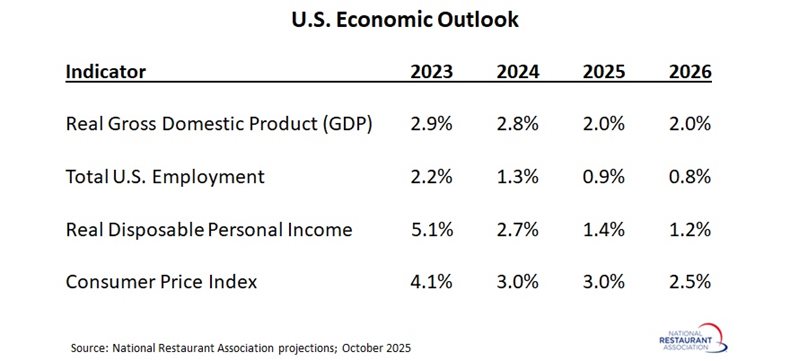
This article presents the latest trends in key economic indicators as well as an outlook for the year ahead. Visit this page throughout the year for the Association’s latest projections for the U.S. economy.
Job growth slowed significantly in recent months
The U.S. economy added just 22,000 nonfarm payroll jobs in August, a notable deceleration from the 79,000 jobs added in July and well below consensus expectations of 75,000. This marks a continuation of the summer slowdown in hiring, with employers adding only 107,000 net new jobs over the past four months. By comparison, the first four months of 2025 saw a robust gain of 491,000 jobs, underscoring the recent loss of momentum.
Revisions to the June and July employment figures further dampened the outlook, subtracting 21,000 jobs from previous estimates. Notably, June’s revised figure turned negative, marking the first month of job losses since December 2020.
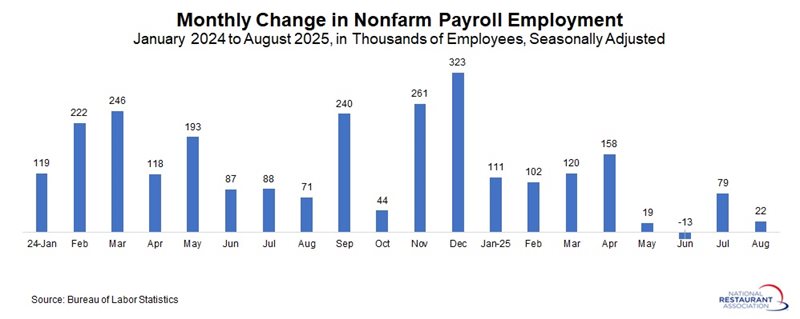
Unemployment rate remains historically low
The unemployment rate edged higher for the second straight month, rising from 4.2% in July to 4.3% in August, a 13-month high. The number of unemployed individuals increased from 7.24 million to 7.38 million, the highest since September 2021. At the same time, the number of employed individuals rose from 163.11 million to 163.39 million, remaining below April’s record high of 163.94 million.
Indeed, these data suggest that the labor market remains not far from full employment, even if it is expected to rise to 4.5% over the coming months.
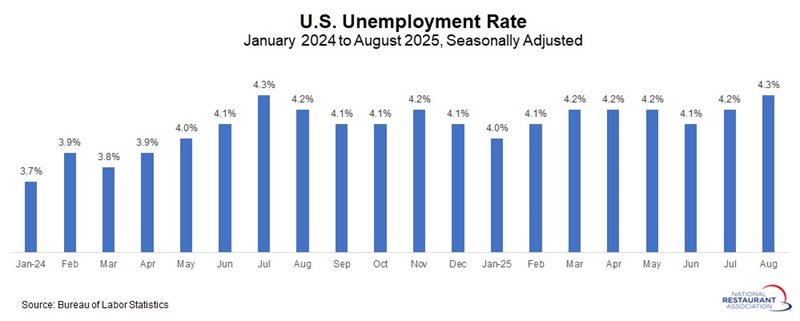
Economy projected to add 800,000 jobs in 2025
Although job growth slowed in recent months, the labor market expansion is expected to continue throughout 2025 – albeit at a more modest pace. The national economy is projected to add a net 800,000 jobs during 2025, well below the 2 million jobs added during 2024. Despite the slowdown, 2025 is expected to represent the 5th consecutive year of job growth, with total gains of just over 17 million jobs since the end of 2020.
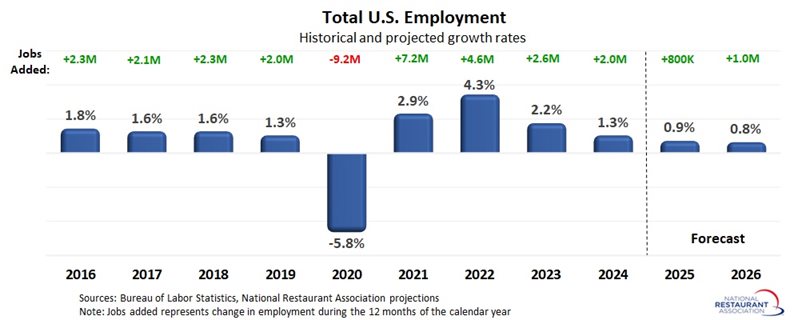
Personal income growth expected to slow
Wage growth is expected to continue in 2025, but decelerating employment gains will likely dampen the increase in aggregate income. Disposable personal income – a key driver of restaurant sales – is projected to increase at an inflation-adjusted rate of 1.4% in 2025. While still positive, that would be down from a stronger 2.7% gain in 2024.
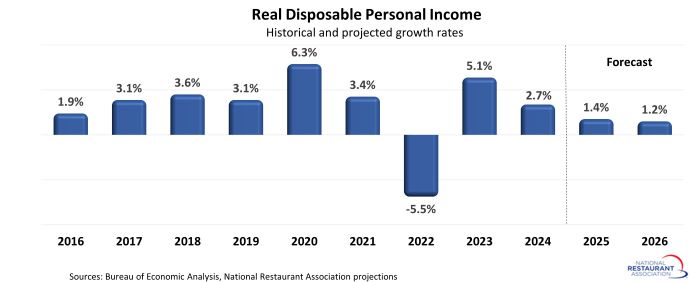
Inflation remains sticky
After hitting a peak of 9.1% in mid-2022 – the strongest 12-month increase in 4 decades – growth in consumer prices moderated in the months that followed. Although progress has been made toward reaching the Federal Reserve’s 2% target level, prices remain sticky in many areas. Adding to the uncertainty is the potential impact that tariffs will have on consumer prices during the second half of 2025. As a result, the National Restaurant Association expects the CPI to increase 3.0% in 2025 on an average annual basis, which would match the 3.0% gain registered in 2024.
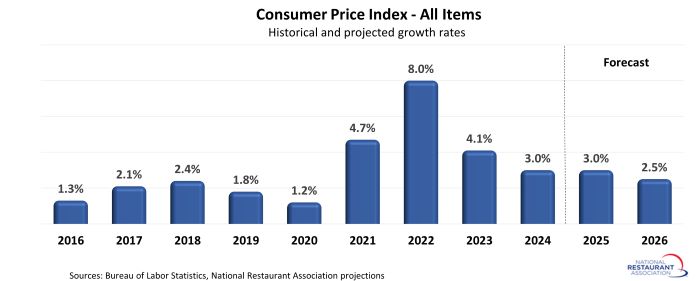
Economic growth expected to remain modest
Overall, the U.S. economy is expected to decelerate somewhat in 2025, with modest gains projected to continue into 2026. Real Gross Domestic Product (GDP)—the total value of goods and services produced nationwide—is forecast to grow by 2.0% in 2025. That marks a slowdown from the robust gains of nearly 3% seen in both 2023 and 2024 and would represent the weakest annual growth rate since 2020. Even so, this outlook reflects a degree of resilience, especially in light of the more pessimistic forecasts issued earlier this year.
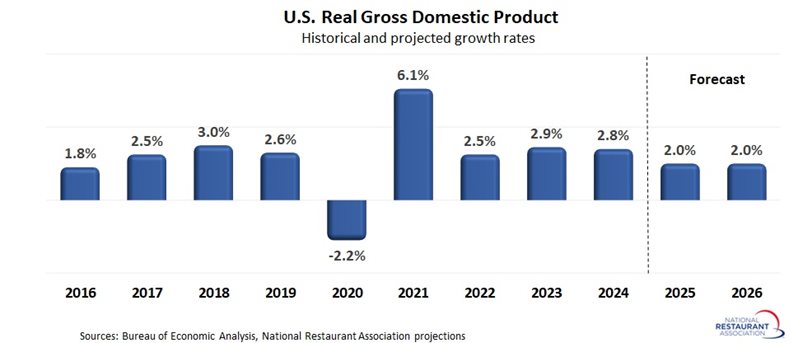
Indeed, the abrupt slowdown in job growth in recent months has been notable. After expanding at an average monthly pace of nearly 123,000 jobs during the first four months of 2025, the labor market added an average of just 27,000 jobs during the last four months. (September data has been delayed due to the government shutdown.) Yet, the unemployment rate remains historically low, even with an expectation that it will notch higher over the coming months. Wage growth also remains solid, albeit with some moderation.
If job creation continues to falter, it could weigh on consumer confidence and spending, particularly in sectors sensitive to discretionary income. For now, however, the economy benefits from strong wage growth and low unemployment, even as risks mount.
Spending continues to buoy the economy. Real GDP jumped 3.8% at the annual rate in the second quarter. To be fair, economic growth in the first half of this year was very “noisy,” with spending shifting in the first and second quarters to reflect time-shifting amid tariff concerns. Yet, projections for the third quarter suggest surprising ongoing strength. The National Restaurant Association forecasts that the U.S. economy will expand by 2.0% in 2025—down from 2.8% in 2024, but stronger than many had anticipated earlier this year.
For its part, the Federal Reserve is likely to continue reducing interest rates at upcoming meetings, with an eye on labor market softness, even as inflationary pressures remain stubbornly elevated. This should help reduce the cost of capital for restaurant operators and stimulate increased consumer spending.

This article presents the latest trends in key economic indicators as well as an outlook for the year ahead. Visit this page throughout the year for the Association’s latest projections for the U.S. economy.
Job growth slowed significantly in recent months
The U.S. economy added just 22,000 nonfarm payroll jobs in August, a notable deceleration from the 79,000 jobs added in July and well below consensus expectations of 75,000. This marks a continuation of the summer slowdown in hiring, with employers adding only 107,000 net new jobs over the past four months. By comparison, the first four months of 2025 saw a robust gain of 491,000 jobs, underscoring the recent loss of momentum.
Revisions to the June and July employment figures further dampened the outlook, subtracting 21,000 jobs from previous estimates. Notably, June’s revised figure turned negative, marking the first month of job losses since December 2020.

Unemployment rate remains historically low
The unemployment rate edged higher for the second straight month, rising from 4.2% in July to 4.3% in August, a 13-month high. The number of unemployed individuals increased from 7.24 million to 7.38 million, the highest since September 2021. At the same time, the number of employed individuals rose from 163.11 million to 163.39 million, remaining below April’s record high of 163.94 million.
Indeed, these data suggest that the labor market remains not far from full employment, even if it is expected to rise to 4.5% over the coming months.

Economy projected to add 800,000 jobs in 2025
Although job growth slowed in recent months, the labor market expansion is expected to continue throughout 2025 – albeit at a more modest pace. The national economy is projected to add a net 800,000 jobs during 2025, well below the 2 million jobs added during 2024. Despite the slowdown, 2025 is expected to represent the 5th consecutive year of job growth, with total gains of just over 17 million jobs since the end of 2020.

Personal income growth expected to slow
Wage growth is expected to continue in 2025, but decelerating employment gains will likely dampen the increase in aggregate income. Disposable personal income – a key driver of restaurant sales – is projected to increase at an inflation-adjusted rate of 1.4% in 2025. While still positive, that would be down from a stronger 2.7% gain in 2024.

Inflation remains sticky
After hitting a peak of 9.1% in mid-2022 – the strongest 12-month increase in 4 decades – growth in consumer prices moderated in the months that followed. Although progress has been made toward reaching the Federal Reserve’s 2% target level, prices remain sticky in many areas. Adding to the uncertainty is the potential impact that tariffs will have on consumer prices during the second half of 2025. As a result, the National Restaurant Association expects the CPI to increase 3.0% in 2025 on an average annual basis, which would match the 3.0% gain registered in 2024.

Economic growth expected to remain modest
Overall, the U.S. economy is expected to decelerate somewhat in 2025, with modest gains projected to continue into 2026. Real Gross Domestic Product (GDP)—the total value of goods and services produced nationwide—is forecast to grow by 2.0% in 2025. That marks a slowdown from the robust gains of nearly 3% seen in both 2023 and 2024 and would represent the weakest annual growth rate since 2020. Even so, this outlook reflects a degree of resilience, especially in light of the more pessimistic forecasts issued earlier this year.
